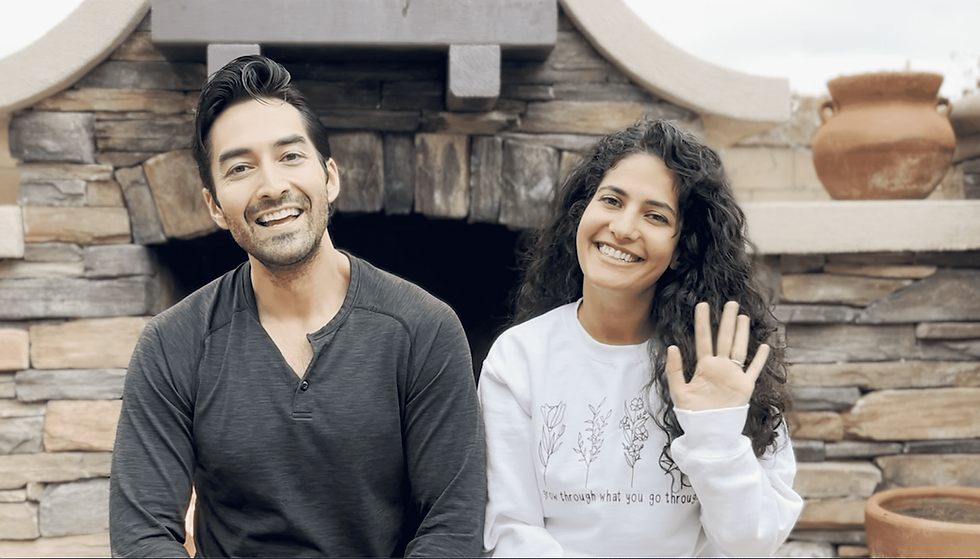How to foster healthy brain development in dance class?
- Amna Mazin

- Jun 13, 2023
- 7 min read
Updated: Jul 2, 2024
Teaching dance to little ones goes much deeper than turns and leaps. Dance teachers get to influence how these young brains create neuron connections that are responsible for their relationship with dance, goal-setting, joy for learning and so much more.

Through years of teaching and learning about child development, I have learned that the early years are crucial.
Ninety percent of a child's brain develops by the age of five and guess which part of the brain is the last to develop? The part that requires focus, logic and reason, also known as the pre-frontal cortex.
The prefrontal cortex actually doesn't develop fully until the age of 25. Yet, adults usually have little patience when little ones are unable to focus or act with reason.
Guess which part of the brain is most active during our children's early childhood? The more instinctive and primitive part of our brain - also called the limbic region and the amygdala.
We all know that children's imagination is extraordinarily strong. Yet, their will to please us is even stronger because that is how they feel secure in a relationship. So, of course, if we want to train our children to not jump in dance class, or we want them to practice every single day, they will do it - to please us. After all, children are highly capable beings and their number one survival need is to belong and be accepted by us.
But what exactly is the best thing for them to learn - that is also developmentally appropriate?
Children need our help connecting their "primitive" brain to their prefrontal cortex in a healthy way. This is the biggest work teachers can do for their students.
In his book Whole Brain Child, Dr. Siegel shares research on the best way to foster healthy brain development in children is by remembering the 4 "S"s:
Seen
Safe
Southed
Secure
1. Feeling Seen
Dr. Siegal calls this the "mindsight". This is when we are able to see past the child's behavior and into their actual emotions and intentions. Here are some examples:
A student comes late to class. A conscious dance teacher is able to see their discomfort and insecurity around showing up late and says "I am so glad you are here. We were missing you." versus further digging into their wound by asking them "Why are you late?" in front of all their peers. These things can definitely be addressed but doing this in private is a lot more effective and trust-building than shaming them in front of their peers. And in my experience, when dealing with younger students, the late factor needs to be addressed with the adults, NOT the little ones.
A student keeps messing up their dance steps. A conscious dance teacher notices that this student messes up their dance steps when performing in front of others or senses their nervousness when corrected in front of others. Such "mindsight" can inform the teacher to give this student tools that will help them build confidence. Such students will thrive if the teacher can give feedback privately and remind them of how awesome they are doing more often. These students will need extra cues from their teacher on what they are doing well.
Dr. Becky also refers to this as noticing that the child's behavior is not who the child is: "This is a good kid, having a hard time.”
When children look at us, they see who we think they are through the mirror or our eyes. That reflection becomes their identity.
By focusing on the goodness of each child, we allow our mind-sight to open up and become curious to all the possibilities and complexities that are at the source of what we see on the outside. And this can only happen if we always, always know without a doubt that the child we SEE in front of us is a GOOD KID.
2. Feeling Safe
Safety is created by trust. Human beings feel safe with people who can hold space for their imperfections and mistakes.
People don't feel safe with those they are afraid of.
Here is an example of what this can look like in a dance classroom:
A student keeps messing up on the same step over and over again.
A non-conscious dance teacher may say: "You are doing it wrong again. How many times have I told you this? This can't happen again. If it does, I am taking you out of this dance."
A conscious dance teacher says: "It seems like you have been practicing this step with the wrong arm. We need to retrain your body to use the other arm. I trust you to work on this by next week. If you have any questions or need help, please come to me after class."
The first example is motivated by fear.It gets the job done but it does so by strengthening negative neural pathways in the brain that are based on fear of punishment and shame as well as a scarcity mindset that highlights the lack of a skill in the child instead of their potential.
The second example may take longer in getting the desired results, but it is founded on nurturing a growth mindset based on love and abundance.It builds positive and healthy neural connections that trusts the goodness of the child and motivates their inner will through love and understanding of their body instead of a fear of punishment and shame.
3. Feeling Regulated (Soothed)
Difficult emotions are inevitable. And how we deal with children's difficult emotions is where teachers can intentionally help connect their students' "primitive" brain to their prefrontal cortex in a healthy way.
Healthy soothing requires a conscious dance teacher to:
1:Name the feeling
2: Validate it
When a student starts crying:
A non-conscious dance teacher may say: "It's ok. You are okay. Don't cry."
A conscious dance teacher says: "You are feeling sad. I know how that feels. Let's go to the side and see how we can help you feel better." If parents or an assistant is available, the teacher can leave the child with them until they get a good cry out. Or the teacher can ask them if they want a hug and let them know it is totally okay to be sad. The student can be allowed to sit down and observe the class until they feel better.
The first example is motivated by our own discomfort with uncomfortable feelings. As good as our intentions might be, invalidating the child's feelings tells their brain that their feelings and thoughts are not real. This is really just due to our society's inability to hold space for hard feelings. However, creating this space is so ESSENTIAL.
The second example soothes the child by holding space for their true feelings. Putting a name to something immediately creates space between the child and the "thing" - their feelings. Their state no longer feels like it is ALL of them. And by relating to their feeling, you help the child feel less alone and as a result that feeling doesn't feel so scary any more. Through such soothing you are teaching the child to regulate and heal whatever may have made them feel sad.
Here is a real example of what this looks like in an Amna Dance classroom:
One of my teenaged students had been consistently late to class for a few weeks now. One particular day she was thirty minutes late. I told her that she missed all of our cleaning for the dance. She could see the disappointment in my face and later that day, she came to me in tears telling me how bad she felt that she disappointed me by coming to class late.
I immediately hugged her and said "One thing you do wrong does not make me forget the 100 things you do right. My respect and love for you has not changed."
This student needed me to soothe her by helping her understand that yes, what she did was wrong but it did not make me respect her any less.
I am grateful she felt safe and secure enough to be vulnerable with me so I can have this moment to soothe her emotions by reminding her that I know she is good inside, no matter what.
THESE MOMENTS are everything!
Paying attention and making space for feelings is some of the most sacred work dance teachers can do.
4. Feeling Secure
Conscious dance teachers can help their students feel secure and self-confident by developing a sense of well-being that comes from within, instead of external forces.
This can be done in multiple ways:
No Comparing! This comes from making sure we don't compare one student with another. They are already doing it amongst themselves, which makes it even more important for teachers to avoid amplifying it any further. Ex: Are you practicing the routine without watching the video? I need you to know it better. (Instead of: She really knows her dance routine. You need to practice more like her. )
Effort Not Outcome! Pointing out how hard our students are working is much more important than focusing on the end result, aka "perfection". This helps them connect to their inner will and enjoy the hard work involved in the process instead of an unhealthy attachment solely to an external result. Ex: Wow! Your turns look so much better today than they did last week.Thank you for your hard work. Let's get you to practice landing it with more balance by next week. (Instead of: You are still doing it wrong. This will look horrible at the recital.)
Feeling secure can be strengthened when we get curious and ask questions. Human beings are programmed to make assumptions and judgements based on inherited beliefs from past experiences and people.
Being curious is the best way to open up our neural pathways so we can create space for more authentic connections with our students.
Your relationship with your students has a huge impact in shaping their brains.
Being mindful of the 4 S' - Seen, Safe, Soothed, Secure - informs the way your student's grow up to see the world.
Even if you say all the right things but don’t really mean it or believe it, they will KNOW. Your students can hear your intentions louder than your words. That’s why the hardest work lies in doing your own self-work - to reframe and rewire unexamined beliefs.
Warm, loving and intentional relationships between dance teachers and students can help develop their confidence, resilience, communication skills and so much more.
These skills are invaluable because they will carry it with them for the rest of their lives.




Comments